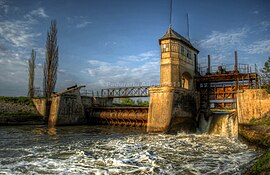Sânmihaiu Român
Sânmihaiu Român | |
|---|---|
 The water gate at the Sânmihaiu Român hydrotechnical node before renovation | |
 Location in Timiș County | |
| Coordinates: 45°42′N 21°5′E / 45.700°N 21.083°E | |
| Country | Romania |
| County | Timiș |
| Government | |
| • Mayor (2020–2024) | Viorel Mărcuți[1] (PSD) |
Area | 88.5 km2 (34.2 sq mi) |
| Elevation | 88 m (289 ft) |
| Population (2021-12-01)[3] | 8,419 |
| • Density | 95/km2 (250/sq mi) |
| Time zone | EET/EEST (UTC+2/+3) |
| Postal code | 307380–307382 |
| Area code | 0256 |
| Vehicle reg. | TM |
| Website | www |
Sânmihaiu Român (Hungarian: Bégaszentmihály or Oláhszentmihály; German: Wallachisch St. Michael) is a commune in Timiș County, Romania. It is composed of three villages: Sânmihaiu German, Sânmihaiu Român (commune seat) and Utvin. It lies on the canalized section of the river Bega, southwest of Timișoara.
Name
| Romanian | Hungarian | German |
|---|---|---|
| Sânmihaiu German | Németszentmihály or Újszentmihály | Rauthendorf or Deutsch St. Michael |
| Sânmihaiu Român | Bégaszentmihály or Oláhszentmihály | Wallachisch St. Michael |
| Utvin | Ötvény | Utwin |
History
The first recorded mention of Sânmihaiu Român dates from 1333, being mentioned in the papal tithe records with the name Sanctus Michael. Historian Ioan Lotreanu considers that the assignment of this name is erroneous, being confused with Sveti Mihajlo in Serbian Banat.[4] However, there are also later mentions in documents, such as a diploma from 1350 in which the locality is named Sanctus Mychael.[5]
Old Romanian village, it resisted the Turkish occupation, so that in 1717, after the conquest of Banat by the Austrians, it had 40 houses. It then appears written on Count Mercy's map from 1723–1725 and on maps from 1761 and 1783. The Romanian church was built in 1774.
In the interwar period it was part of Plasa Chișoda, Timiș-Torontal County, it had over 2,000 inhabitants and over 500 houses.
Demographics
Religious composition (2011)[7]
Sânmihaiu Român had a population of 6,121 inhabitants at the 2011 census, up 39% from the 2002 census. Most inhabitants are Romanians (88.01%), with a minority of Hungarians (2.45%). For 7.47% of the population, ethnicity is unknown.[6] By religion, most inhabitants are Orthodox (73.7%), but there are also minorities of Pentecostals (9.67%), Roman Catholics (3.97%) and Baptists (1.32%). For 7.76% of the population, religious affiliation is unknown.[7]
| Census[8] | Ethnic composition | |||||
|---|---|---|---|---|---|---|
| Year | Population | Romanians | Hungarians | Germans | Roma | Serbs |
| 1880 | 4,337 | 2,733 | 113 | 1,455 | – | 4 |
| 1890 | 4,753 | 2,952 | 208 | 1,523 | – | 39 |
| 1900 | 5,011 | 2,929 | 285 | 1,745 | – | 46 |
| 1910 | 4,726 | 2,898 | 433 | 1,317 | – | 22 |
| 1920 | 4,384 | 2,715 | 368 | 1,238 | – | – |
| 1930 | 4,578 | 2,982 | 343 | 1,182 | 44 | 10 |
| 1941 | 4,547 | 2,978 | 383 | 1,113 | – | – |
| 1956 | 4,114 | 3,103 | 343 | 625 | 23 | 13 |
| 1966 | 4,430 | 3,528 | 381 | 471 | 25 | 16 |
| 1977 | 4,767 | 4,002 | 289 | 404 | 49 | 12 |
| 1992 | 3,911 | 3,608 | 157 | 82 | 41 | 10 |
| 2002 | 4,396 | 4,130 | 132 | 66 | 40 | 9 |
| 2011 | 6,121 | 5,387 | 150 | 32 | 45 | 18 |
Notable people
- Ciprian Radovan (b. 1939), painter, art critic and scientist
Twin towns
References
- ^ "Results of the 2020 local elections". Central Electoral Bureau. Retrieved 16 June 2021.
- ^ "Comuna Sânmihaiu Român". ADI-PCT.
- ^ "Populaţia rezidentă după grupa de vârstă, pe județe și municipii, orașe, comune, la 1 decembrie 2021" (XLS). National Institute of Statistics.
- ^ Lotreanu, Ioan (1935). Monografia Banatului. Timișoara: Institutul de Arte Grafice „Țara”. p. 365.
- ^ Crețan, Remus (2006). Dicționar toponimic și geografico-istoric al localităților din județul Timiș. Timișoara: Editura Universității de Vest. p. 134. ISBN 973-7608-65-8.
- ^ a b "Tab8. Populația stabilă după etnie – județe, municipii, orașe, comune". Institutul Național de Statistică.
- ^ a b "Tab13. Populația stabilă după religie – județe, municipii, orașe, comune". Institutul Național de Statistică.
- ^ Varga, E. Árpád. "Temes megye településeinek etnikai (anyanyelvi/nemzetiségi) adatai 1880-2002" (PDF).
- ^ "Informații generale". Primăria comunei Sânmihaiu Român.




